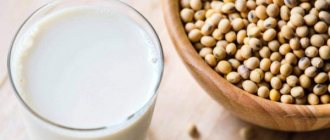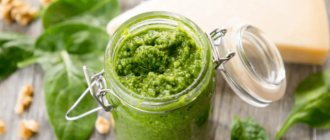Soy milk: benefits and harms, how to use, recommended quantities, diseases for which the product is undesirable to use. These and many other questions are of interest to those who want to replace cow's milk with a drink or simply lose unwanted pounds. Discussions about the positive and negative aspects of the product have been going on for years, because along with useful components, the composition contains undesirable ones. Manufacturers correct the product’s shortcomings by adding calcium, but some points should still be taken into account before purchasing a package of the drink. Information on how to choose the right one, who should not use it, what are the benefits for the human body and what can replace this ingredient from Asian cuisine is given in the text below.
Technological process of soy milk production
History of soy milk
The production of a drink from a legume called soy began in the second century (AD) in the Asian state of China. According to history, the idea of creating a product came to the mind of the Eastern thinker Liu An. The reason why the man ground soybeans and made a drink from the resulting powder that looked similar to milk was because his mother had lost her teeth. The elderly woman loved beans, but could not eat them, and her thinking son came to the rescue.
For many centuries, Europeans did not know about the existence of soy milk, and only in 39 of the last century the drink was presented to the whole world by Harry Miller - now industrial production began. It was during this period that the vegetarian trend in food became widespread and the product began to have consumers. Nowadays, all over the world there are more than one thousand people who regularly drink this drink in its pure form or use it as an ingredient in dishes due to its large number of beneficial properties.
Harm of soy milk powder
Separately, it is worth mentioning about soy milk powder. It is important to understand that such a product is subject to additional processing, including chemical processing. In any case, the more processing a product has undergone since its natural stage, the less benefits it contains. Soy milk powder contains so-called hydrogenated fats or trans fats. We have previously talked about the harmfulness of trans fats and their destructive effects on the human body. And the trans fat content in soy milk powder is from 20 to 30 percent. Decent.
The content of soy protein itself in soy milk powder is about three percent. It may also contain dipotassium phosphate, which is formally safe. In the food industry, it is added precisely to instant products with milk (!) protein. And then the most interesting thing - in the composition of soy milk powder you can often find sodium caseinate, yes, exactly - milk protein. Thus, not only may soy milk powder not be a vegan product, but it can also be life-threatening if you have a milk protein allergy. After all, often the reason for its use is an allergy to cow's milk.
How is soy milk made?
The technology for making soy milk includes the following stages:
- soybeans are ground;
- the beans are soaked in water (the ratio of components in the mixture (grains/liquid) in parts is 1:4; 1:8; 1:12) after mixing with the help of specialized blades;
- filtered (the resulting sediment is used as livestock feed);
- boil at one hundred and fifty degrees Celsius;
- poured into specialized containers that ensure tightness and protect from light.
Over the millennia, the process of obtaining this product has not changed much: this scheme was also used by Chinese and Japanese farmers. High temperature treatment prevents the risk of microorganisms multiplying inside the packaging, so unopened containers can be stored for up to twelve months, and opened for seven days.
What is soy milk
Presumably, the phenomenon of soy milk originated in East Asia. To obtain it, take soybeans and soak them for several hours. Then the soaked beans are crushed into a puree, and after this puree is subjected to heat treatment in the form of cooking.
After the resulting liquid has cooled, it is filtered and, in fact, the finished product is obtained - soy milk. This liquid is quite rich in protein - about three percent of the total mass, as well as various microelements. During industrial production, the final product is additionally enriched with vitamins such as calcium and B12 to maximize the similarity of soy milk with cow's milk in terms of nutritional value. However, to what extent this method allows the absorption of these vitamins is an open question.
Calorie content and composition of soy milk
The undeniable advantage of a non-milk product over traditional forms of milk is its low calorie content due to the low fat content in its chemical composition. Before calculating the calorie content of a dish, you should take into account the value given on the packaging, because for different manufacturers the values depend on the presence of additives in the product. The average value ranges from 45 to 60 kilocalories per hundred grams of product (numbers correspond to grams):
- proteins/2.94;
- fat/1.99;
- carbohydrates/3.05;
- dietary fiber/0.4;
- water/85.6;
- ash substances/0.64.
The vitamin and mineral composition of soy milk is presented in the table:
Chemical composition of soybean product
| Group/Element | Effect on the body | Amount per hundred grams, grams/percentage of daily requirement,% |
| Tocopherol acetate | Antioxidant | 0,11/0,7 |
| Thiamine | Strengthening the nervous system | 0,06/4,0 |
| Riboflavin | Participates in metabolic processes | 0,07/3,8 |
| Kholin | Normalization of the functioning of the nervous system, regulation of the amount of sugar in the circulatory system | 23,6/4,7 |
| Pantothenic acid | Wound healing, antibody synthesis | 0,37/7,5 |
| Pyridoxine | Synthesis of hemoglobin and red blood cells | 0,08/3,9 |
| Folic acid | Normalization of emotions | 0,018/4,5 |
| A nicotinic acid | Reducing cholesterol levels in the circulatory system | 3,29/2,6 |
| Cholecalciferol | Maintains phosphorus-calcium balance | 1,2/0,0 |
| Ascorbic acid | Improving blood composition | 7,2/0,0 |
| Potassium | Participation in exchange processes | 118/4,7 |
| Calcium | Regulates the activity of the cardiovascular system | 25/2,5 |
| Magnesium | Regulation of the nervous system | 25/6,3 |
| Phosphorus | Support of teeth and tissues | 52/6,5 |
| Sodium | Ensures normal growth | 51/3,9 |
| Zinc | Strengthens the immune system | 0,2/1,0 |
| Copper | Anti-inflammatory, boost immunity | 0,1/12,8 |
The product is rich in vitamins and minerals, but do not forget about the presence of other components, which in some cases have a negative effect on the body.
Soy milk can be consumed by vegans and people allergic to lactose
What is the secret of soy milk
According to nutritionists and doctors, the uniqueness of this plant product is high. It contains a lot of protein and contains almost all the amino acids necessary for building body tissues. There are triglycerides, as well as lipoid compounds in the oils. They are enough to replenish the body's daily energy losses. Their main part is unsaturated fatty acids, essential for human health. There are almost as many lipids as in skim cow's milk. As for carbohydrates, since this is a natural plant product, it contains starch, some pectins, and fructose. There is glucose and sucrose. But the percentage of sugars is less than in animal milk, so the soy product is classified as dietary.
Some complain that it contains few calcium compounds. But when soybean cake is prepared at the factory and filled with water, it is necessarily saturated with soluble substances necessary for humans with calcium ions in the required quantity.
Scientists note an important property of the product: giving the body the required amount of proteins. Moreover, in quantities that can be compared with such a valuable product as meat. Despite the fact that soybeans are a plant, their beans contain eight amino acids required for the synthesis of protein-enzymes, which not only participate in metabolism, but also help with brain function, as well as in maintaining the required level of immunity.
The composition of soy milk is balanced in terms of “vitamin richness”. This is a pantry where vitamin E, folic acid, all representatives of group B, PP, many different macroelements and substances containing microelements are stored, which are necessary for the female body.
That is, what is needed for health, the synthesis of enzymes and hormones, is there. Moreover, there are special compounds that help in cell regeneration and enable human organs to function fully. If you want to be healthy, maintain beauty and youth for as long as possible, then drinking soy milk daily will help you.
There are people who cannot tolerate proteins from animal derivatives. Allergies, gastrointestinal disorders occur, and in some people the body has a negative reaction to lactose. Soy milk helps them out; it is also recommended for those who suffer from galactosemia. The low sugar content of the product makes it indispensable for some forms of diabetes.
And for a healthy person it is prescribed as part of a diet aimed at losing weight. Moreover, it was noted that during this period the work of the heart muscle normalizes, cholesterol in the blood decreases, and the condition improves if a person suffers from peptic ulcers or chronic cholecystitis.
The drink is especially useful for people of retirement age. Lecithin, which is included in its composition, regulates the amount of cholesterol. The condition of the skin improves, the nail plates and hair are restored.
When women reach menopause, the body experiences discomfort. As American experts say: “For women, the benefits of soy milk are obvious: it alleviates the condition during menopause, because the isoflavones contained in the cake are analogues of estrogens and prevent osteoporosis.”
How to properly consume soy milk
This product can be used as a plant-based alternative to goat or cow milk for the preparation of various desserts, cereals, soups, and can also be used in its pure form. It is worth remembering that the product has its own benefits for the body, but with excessive or prolonged use it can leave a negative imprint.
Characteristics:
- neutral in taste;
- presence of a slight nutty odor.
Due to the presence of glutamic acid in the composition, when sugars, cinnamon, honey and other additional components are added, the flavor is fully developed.
How much can you drink per day
Excessive use of the drink can cause metabolic disorders and disruptions in the functioning of the endocrine system, which is highly undesirable for people under the age of sixteen. This product should be used by adults with strict adherence to quantities and with caution, in the presence of acute forms of chronic diseases only after consultation with a doctor.
Standards for use of the product in its pure form are given in the table:
| Group of persons | Quantity, milliliters |
| Children under 16 years old | Not recommended |
| 16-18 years old | 250,0 |
| Healthy adults/pancreatitis/diabetes | 500,0/200,0/500,0 |
| Pregnancy, breastfeeding | 0,0 |
There are some groups of people for whom the use of the product is highly undesirable (see below).
Is it possible to drink soy milk during fasting?
During Lent, Christians should abstain from consuming products obtained from animals. Since soy milk is not significantly related to the traditional forms obtained from cows and goats, this product is not prohibited for consumption during fasting. Due to the high content of high-quality proteins, the drink can fully replace the meat component of the kitchen, but you should not abuse it, exceeding the recommended quantities, and switch to systematic long-term use.
Is it possible to have soy milk for pancreatitis?
The product made from soybeans is easy to digest, which plays a special role in pancreatic diseases, without creating additional stress on the organ. Compared to traditional types of milk - cow's, goat's - consumption does not lead to bloating, flatulence and other complications due to the lack of fat in the product. Despite the undoubted benefits, the product can negatively affect the body with this disease due to:
- presence of plant fiber;
- possible genetic modification of the crop;
- the presence of phytic acid (removes minerals);
- flavoring and aromatic additives.
To avoid side effects of the product, it is advisable to prepare the milk yourself, because the manufacturing process is extremely simple. Recommendations are given in the table:
| Parameter | Acute form | Remission |
| Days when can be applied | The fourth day after an exacerbation - a component of meals Ten-fourteenth – no more than one hundred milliliters/day | Upon completion of the acute stage |
| Suitable form of use | Dairy/fermented milk dishes | Possibly in its purest form |
| Long-term use | Not advisable | Not advisable |
Experts recommend drinking not a pure drink if you have pancreatitis, but preparing dishes from it. The maximum amount that can be obtained per day from food if you are ill is two hundred milliliters.
Use for type 2 diabetes
Diabetes happens:
- first type;
- second type;
- gestational.
The first is classified as a disease characteristic of childhood patients, the second is an adult disease, and the third is acquired by women during gestation (pregnancy). The main differences between the first and second are the level of glucose in the circulatory system (with the second higher) and the production of insulin - with the first the hormone is produced, with the second - partially. An increased sugar content means the need for constant monitoring of the diet. Experts recommend drinking soy milk for type 2 diabetes, but with the following recommendations:
- only after consultation with a nutritionist;
- start with small quantities;
- not advisable before bedtime (preferably in the morning or afternoon);
- condition monitoring;
- the maximum amount per day is two glasses.
This drink promotes weight loss, does not contain cholesterol, the protein is similar to meat and can replace meat, but you should not go on a diet and take only soy milk - this will lead to a lack of nutrients in the blood and leaching of minerals. If you have diabetes, you should not exceed the recommended daily amounts of the product.
Soy improves body function
Soy milk: harm
However, is everything so clear? Can I drink soy milk? Speaking about the dangers of soy milk, first of all it is worth saying that soy is often genetically modified. Such soybeans are created to increase its resistance to herbicides. The fact is that growing soybeans is associated with a problem such as weeds that can inhibit it; to solve this problem, soybeans are treated with herbicides that are powerful enough that there is a danger of the plant itself dying. And to preserve the plant, soybeans are modified to be resistant to chemicals like Glyphosate and Dicamba.
For example, the herbicide manufacturer Bayer produces not only herbicides, but also varieties of GMO soybeans that are resistant to them1. Thus, the production of GMO soybeans is an incredibly profitable business, because it allows you to completely destroy all weeds while preserving the harvest.
And the main problem is not even the modification of soybeans itself, but the fact that its resistance to herbicides allows farmers to spray them in “horse” doses, which naturally affects the quality of the crop - it contains a high concentration of these harmful chemicals.
We have already talked about the dangers of herbicides earlier.
So much of the problem with soy milk is that most of the soy comes from China, where herbicide treatment is very popular. To avoid this problem, it is better to buy soybeans and soy milk that are grown in environmentally friendly conditions and, best of all, domestically produced, since in our country the cultivation of GMO soybeans is prohibited by law.
It's also worth noting that soy milk has other negative aspects. For example, it contains a high concentration of phytic acid. According to the results of scientific research, this prevents the absorption of important microelements: magnesium, calcium, zinc and iron, which actually does not allow these substances, which seem to be contained in the product itself, to be fully absorbed2.
Benefits and harms for the human body
The filtrate from soybeans soaked in water and pureed has an ambiguous effect on the human body. The complete absence of certain substances can have a positive effect on some groups of people and leave a negative imprint on others. The product should be used with caution, in compliance with standards and recommendations, and preferably after consultation with a specialist. The positive aspects are expressed by the following effects:
- rejuvenating thanks to the antioxidants present in the chemical composition;
- prevention of certain cancer diseases;
- stabilization of blood lipid profile;
- improvement of blood vessels due to the polyunsaturated fatty acids contained;
- preventing the occurrence of osteoporosis.
Negative effects in the form of:
- metabolic and hormonal disorders due to the high content of phytoestrogens;
- Isoflavones, useful during menopause, can cause early menstruation in childhood;
- impaired function of the endocrine system in men who are not overweight;
- mineral deficiency;
- early birth or early miscarriage during pregnancy
Do not rush into panic and draw conclusions about the obvious negative impact of the product. When consuming moderate quantities and strictly observing contraindications, the positive effect will not take long.
Soy milk powder
The milk powder production system is multi-stage, so consumption is highly undesirable in the presence of pancreatitis and other diseases in acute and chronic forms. After filtration, the sediment is sent as feed for livestock, and part of the purified liquid is used for the production of a concentrated component (milk powder), producing:
- thickening;
- homogenization;
- drying.
Thus, the dry form does not differ in properties from the liquid form; it is a concentrated powder that can also be used by dissolving in water. Manufacturers often add various flavoring and aromatic substances and preservatives to impart new properties and extend shelf life.
Characteristics:
- gluten, cholesterol free;
- amino acids and antioxidants in the composition;
- complete digestibility;
- prevents the occurrence of diseases associated with the cardiovascular and nervous systems.
Harm and contraindications of soy milk
In addition to substances that have a positive effect on the human body, the drink contains compounds that can cause harm if the recommendations are not followed:
- phytoestrogens;
- phytic acid.
The former are dangerous because they affect the thyroid gland and metabolic processes. If used in childhood or during pregnancy or breastfeeding, there is a high probability of hormonal changes. Phytic acid is able to bind to minerals and remove them from the body, which, with prolonged use, can provoke a deficiency of calcium and other minerals. Manufacturers strive to eliminate this deficiency by artificially enriching them with elements, but this does not mean that the recommendations should not be followed.
Contraindications:
- childhood;
- diseases related to the thyroid gland;
- period of pregnancy, breastfeeding;
- tumors;
- oncological diseases.
Side effects:
- disruption of the functioning of the gastrointestinal tract;
- digestive disorders;
- disruption of redox processes in the circulatory system;
- decreased absorption of protein substances;
- negative effect on the pancreas.
Benefits of soy milk
For men
Recommended by endocrinologists for those representatives of the stronger sex who suffer from excess weight. The substances contained in soy help stabilize hormonal levels and suppress estrogen produced in the body.
Men who are not obese can consume milk, but with caution, do not go beyond the daily norm and do not make the product part of the daily diet. An excess of soy can lead to changes in the endocrine system and disturbances in the functioning of the genital organs.
For women
Soy contains substances such as isoflavones. They can benefit the female body, with the exception of periods of pregnancy and breastfeeding. Replacing animal milk will be useful:
- to relieve painful symptoms during premenstrual syndrome;
- neutralization of estrogens during menopause;
- prevention of breast cancer.
During menopause
Phytoestrogens contained in soy help stabilize hot flashes, due to the fact that human estrogens can be compensated for by plant analogues. This effect has not been confirmed by conclusive clinical studies. There is reason to believe that the results depend on whether milk was used regularly from an early age.
For children
Soy products have been used in European cuisine for a short period of time, so the necessary statistical data on the effect of plant-based milk on the child’s body has not yet been accumulated. Doctors advise not to use this product when feeding children under 1 year of age. Throughout preschool age, you should be careful to include soy in your diet in limited quantities.
If the child is allergic
Although it is recommended to consume soy drink with caution in children, there are also those among children who are intolerant to gluten and lactose-containing products. Such children and adolescents cannot consume traditional milk from cows and goats. Soy products can become an affordable alternative that can provide a growing body with all the necessary nutrients.
Benefits for weight loss
Regular use of soy products for weight loss may be a good option due to their low calorie and fatty acid content. But do not lose sight of the negative consequences that are caused by long-term consumption of soy.
How to make soy milk at home
Soy milk can serve as an alternative to traditional forms of milk. Despite the fact that the product has nothing to do with cow's or goat's milk, the finished dishes have a similar taste.
Soy milk recipe
Natural soy milk without preservatives, dyes, flavors, or sugars can be used as an ingredient in cooking or cosmetic purposes. A product prepared with your own hands will give you confidence in the composition.
Components that will need to be prepared and measured in advance:
- soybeans/two hundred grams;
- water/one liter.
Manufacturing instructions:
- Combine soybeans with water and leave for six to twelve hours. The water should be changed every two hours. This will help avoid saturating the milk with extraneous flavors. The husks that fall on top should be removed.
- After the specified time period, the culture will increase in size; it must be washed well with water before the next stage.
- Place the resulting mass in a blender container, add water so that it covers the surface of the soybeans.
- Place the puree mass in a heat-resistant bowl and put on fire, bring to a boil, cook for twenty-five minutes, eliminating any foam that forms.
- Place several layers of gauze on the neck of a liter or two-liter container, pass the resulting mass through the gauze, and squeeze it out.
- The yield is six hundred milliliters, the storage time in a dark place protected from sunlight is 72 hours.
Pancakes with soy milk
How to make at home
You can get a natural product by preparing it yourself. To make it, you only need 2 ingredients: water and soybeans.
The beans are soaked for half a day, and the water should be drained and changed several times. Before cooking, rinse the beans thoroughly. The beans are ground in a blender, water is added to them, after which it is the turn of heat treatment.
After boiling, you need to cook the mixture for half an hour. Then you need to strain the resulting mass through several layers of gauze. The shelf life of the finished homemade product is 2 days.
Recipes using soy milk
Pancakes with soy milk
The recipe is suitable for use during Lent. Components that will need to be prepared and measured in advance:
- wheat flour/glass;
- milk/two glasses;
- sunflower oil/one hundred milliliters;
- vanilla/optional;
- salt/pinch;
- sugar/two tablespoons;
- baking powder/one teaspoon.
Cooking instructions include the following step-by-step steps:
- Mix flour with salt and sugar.
- Separately, mix soy milk with vegetable oil, stir, add soda dissolved with apple cider vinegar, stir.
- Combine the two mixtures, beat with a mixer or blender.
- Heat a frying pan, grease with oil, bake pancakes on both sides.
Soy milk pancakes
Components that will need to be prepared and measured in advance:
- wheat flour/glass;
- milk/glass;
- sunflower oil/two tablespoons;
- vanilla/optional;
- salt/pinch;
- sugar/to taste;
- baking soda/quarter teaspoon;
- apple cider vinegar/teaspoon.
Cooking instructions include the following step-by-step steps:
- Mix milk with flour, salt, sugar, vanillin, baking powder, beat with a blender until homogenized.
- Heat a frying pan, grease with oil, bake the pancakes until cooked on both sides.
Omelet with soy milk
Components that will need to be prepared and measured in advance:
- chicken egg/one piece;
- soybean milk/four hundred milliliters;
- salt/to taste;
- butter/ten grams.
Cooking instructions include the following step-by-step steps:
- Grease the mold with butter.
- Place the ingredients (eggs, salt) in a bowl, stir, add milk.
- Pour the mixture into a mold, place in an oven preheated to one hundred and eighty degrees, bake for twenty minutes.
Soy milk curd
Components that will need to be prepared and measured in advance:
- lemon juice/two tablespoons;
- water/tablespoon;
- soybean milk/one liter.
Cooking instructions include the following step-by-step steps:
- Heat the milk without bringing it to a boil.
- Add a tablespoon of water to the lemon juice.
- Pour lemon juice and water into milk.
- Cover the mixture and leave for twenty minutes.
- When the milk has curdled, place the resulting mass in a cotton cloth and squeeze out.
- Keep the cottage cheese in the sheet, placing a weight on top, for another thirty minutes.
- When excess liquid comes out, the curd is ready.
You can read about the benefits and harms of cottage cheese on this page: .
Soy milk cheese
Components that will need to be prepared and measured in advance:
- citric acid/two grams;
- soy milk/two glasses.
Cooking instructions include the following step-by-step steps:
- Soy milk, place on fire, cook for ten minutes.
- Pour citric acid into the resulting mass and stir.
- Cover the mixture and leave for twenty minutes.
- When the milk has curdled, place the resulting mass in a cotton cloth and squeeze out.
- Keep the cheese in the sheet, placing a weight on top, for another thirty minutes.
- When excess liquid comes out, the cheese is ready.
Porridge with soy milk
Vegetable vs cow
As we already wrote above, comparing these products is not very correct. Yes, and talking about which product is healthier is the same. Yes, plant milk contains less fat and contains some useful macro- and micronutrients (by the way, you can get them from other foods). Whereas cow's milk contains casein, to which, albeit rarely, allergies still occur, and lactose, which is associated with food intolerance, and an insulin-like growth factor, which increases the risk of tumor development. But it is important to understand that in the light of current nutritional knowledge, it is impossible to talk about the benefits and harms of any products in general, for everyone. Each person has an individual biochemical intolerance. Even very healthy coconut milk can develop an allergy (this happens if there is an aggravated reaction of the immune system to latex), and the same person can drink the same cow’s milk without harm to health.
As a summary, we can say that plant milk cannot be considered a substitute for cow's milk. There are not very many benefits in it, other than coconut. Some types of milk (from nuts) are completely inappropriate in the diet of overweight people and a number of inflammatory diseases.
What kind of milk, besides coconut milk, can be recommended to all supporters of a healthy lifestyle?
Milk from chia seeds or, for example, flaxseed. But, alas, such plant milk can only be made independently. It is not yet produced on an industrial scale.
Recipes for porridge with soy milk
Rice porrige
The scheme is similar to a dairy product. Components that will need to be prepared and measured in advance:
- rice cereal/fifty grams;
- water/one hundred milliliters;
- soybean milk/two hundred milliliters;
- butter/ten grams;
- salt/pinch;
- sugar/to taste.
Cooking instructions include the following step-by-step steps:
- Rinse the cereal, combine with water, salt, sugar, cook for twenty minutes.
- Pour soy milk into the mixture and cook until tender.
- Remove from heat, brush with butter.
Semolina
The scheme is similar to a dairy product. Components that will need to be prepared and measured in advance:
- semolina / four tablespoons;
- water/tablespoon;
- soybean milk/five hundred milliliters;
- butter/ten grams;
- salt/pinch;
- sugar/to taste.
Cooking instructions include the following step-by-step steps:
- Pour milk over the cereal, add water, salt, sugar, and set aside for ten minutes.
- Bring the mixture to a boil, cook for three minutes with the lid closed.
- Remove from heat, brush with oil.
Oatmeal
The scheme is similar to a dairy product. Components that will need to be prepared and measured in advance:
- oatmeal/one hundred and twenty grams;
- soybean milk/three hundred milliliters;
- butter/ten grams;
- salt/pinch;
- sugar/to taste.
Cooking instructions include the following step-by-step steps:
- Combine the cereal with milk, salt, sugar and cook for twenty minutes.
- Remove from heat when ready, brush with butter.
Soy milk drinks
Coffee with soy milk
Serves as an alternative to the traditional one during Lent. Components that will need to be prepared and measured in advance:
- coffee beans/one teaspoon;
- cold water/two hundred milliliters;
- sugar/to taste;
- soy milk/one teaspoon.
Cooking instructions:
- Grind the beans by placing them in a coffee grinder.
- Place water in a pot, add ground coffee, place on fire, and brew the drink.
- First add the required amount of sugar to the finished coffee, and then add the milk component.
Soy milk with vanilla
To make vanilla-infused soybean milk, follow the homemade recipe above. You need to add vanilla to the finished mass.
Cocoa with soy milk
A drink made from soy milk will not yield to the taste of cow milk.
Components that will need to be prepared and measured in advance:
- cocoa/no more than two tablespoons;
- soy milk/five hundred milliliters;
- sugar/to taste.
Cooking instructions include the following step-by-step steps:
- Pour the milk into a small container, put it on the fire, heat it up without boiling.
- Mix the specified amount of cocoa with the required amount of sugar, add a little boiling water, stir.
- Combine the milk with the prepared mixture of cocoa and sugar, place on the fire, boil, removing the foam.
Soy milk kefir
The manufacturing process is similar to cow's milk.
Components that will need to be prepared and measured in advance:
- soy milk/liter;
- kefir of any fat content/two tablespoons.
Cooking instructions include the following step-by-step steps:
- Measure out the milk and place it in a jar.
- Pour in kefir and stir.
- Place the mixture, covered with a lid, in a warm place.
- After twelve to eighteen hours, enjoy the finished kefir.
Soy milk in cosmetology
The chemical composition of the product is able to provide the body with nutrients not only from the inside, but also when used externally. Effect on the epidermis due to the isoflavones contained:
- rejuvenating;
- protective;
- elimination of greasy shine;
- elimination of bruises, dark circles (just moisten a cotton pad and leave it in the area around the eyes for ten minutes).
To make masks for use on the face, only homemade milk should be used; additives added to the industrial product can cause allergic reactions. Straining is not necessary when using the drink for cosmetic purposes.
Face and décolleté mask
Before mixing, measure out the following ingredients:
- two tablespoons of soy milk;
- twenty milliliters of lemon juice;
- two tablespoons of olive oil.
Preparation: Wash the lemon, remove the peel, squeeze the juice through cheesecloth, add milk and oil heated to forty degrees (a water bath is suitable for heating), stir until homogenized.
Application: Apply the resulting mixture to the steamed, cleansed epidermis, leave for fifteen minutes, remove with a damp cloth.
Result: Lightening, elimination of pigmentation, nutrition.
How to choose and store correctly
If you cannot prepare the drink yourself, you can use the resources of retail chains, taking into account the following:
- the presence of sugars, color, taste, and smell enhancers is undesirable;
- the presence of the entry “isolated soya protein” indicates a low-quality product; you should not purchase such a product;
- the addition of vitamins and minerals is encouraged to enrich the composition;
- sunlight has a negative effect on a product rich in vitamins, so the container must be airtight and opaque;
- compliance with the expiration date.
If the product meets these requirements, after opening the packaging must be closed to protect it from air and placed in the refrigerator. The drink should be stored in this state for no longer than seven days. Products that do not meet the expiration date should not be consumed.
Reviews
There are various reviews about soy milk on the Internet, the negative ones are associated with the dishonesty of manufacturers: buyers complain about the presence of sugar, the taste of water and other shortcomings of some brands. Before purchasing, you should carefully study the composition, giving preference to natural products with a sign of the absence of genetic modification (GMO). The Alpro brand is recommended by 100% of buyers, the average rating on various sites is 4.9 out of 5.0.
Irina, 35 years old
For an allergic child with lactose and gluten intolerance, you have to carefully select ingredients for preparing dishes. To add variety to my diet, I purchased soy milk, which I heard a lot of good things about from a friend. First impression: tasty, healthy drink, did not cause allergies. I will definitely buy again, I recommend.
Maxim, 45 years old
Having seen soy milk on sale in the Magnit chain, I bought it out of interest. I didn’t expect such a taste from soy; it contains sugar, which is a slight minus. My wife made pancakes from the drink, which surprised me - they weren’t much different from those made with milk. I recommend.
Maria, 50 years old
I heard about the benefits of soy milk for women and decided to try it. It's more expensive than cow's milk, but it's worth it. The product does not contain cholesterol, which plays a special role for me due to heart disease, and it tastes good. I recommend.
Composition and calorie content of soy milk
Soy milk belongs to the category of low-calorie products. There are about 40 kcal per 100 g of finished raw material. The calorie content of such a product is twice as high as that of whole cow's milk. BJU of soy drink: proteins - from 0.8 to 3.7 g, fats - from 0.35 to 1.5 g, carbohydrates - 7-8 g.
The product does not contain lactose, which is why it is considered dietary. Soy milk is successfully used as a substitute for regular milk in cases of allergies and individual intolerance in humans.
The beneficial qualities of soy milk are due to its unique chemical composition. The product contains:
- vitamins: A, K, E, C, group B (1, 2, 4, 5, 6, 12.9), D, PP;
- lecithin;
- unsaturated fatty acids;
- phytoestrogens of natural origin;
- minerals: calcium, sodium, potassium, iron, phosphorus, magnesium, copper, selenium, manganese, zinc.
Conclusion
- Soy milk does not contain cholesterol and fat, which is an advantage over goat and cow milk - a particular benefit for those who want to lose extra pounds and those suffering from heart disease.
- The chemical composition contains high-quality proteins, which are similar in structure and properties to animals, and therefore are easily absorbed by the human body.
- Soy milk does not contain lactose, the milk sugar that is not tolerated by a large percentage of people, and also contains a small amount of gluten, which can cause allergic reactions. Both properties are beneficial for people prone to allergies.
- Feed soybeans are genetically modified to increase yield. Other varieties of plants are used to make milk, so the packaging must have a corresponding inscription.
- The drink contains phytoestrogens and female hormones, which limits the possibility of use in children and other groups of people.
Soy and almond milk: benefits and harms
Recently, plant-based milks made from soy, oats, almonds and coconut have been growing in popularity. According to Nielsen, in the first quarter of 2018 in Russia, sales of such plant-based drinks increased by 154% compared to 2021. At the same time, consumption of traditional pasteurized milk in Russia over the same period decreased by 1.1%, as reported by the Roskachestvo portal.
The American organization Consumer Reports (similar in its activities to Roskoshestvo) examined the nutritional value of 35 plant-based drinks: almond, soy, coconut and oat milk. Products with natural milk and its main beneficial components - protein, calcium, potassium and several vitamins of groups B, A and D.
Experts have found that soy is closest to the nutritional composition of milk. However, some products have added ingredients such as sugar, flavorings, stabilizers and carrageenan. On the Russian market, plant milk is also often found containing sugars, flavorings, stabilizers (gellan gum, calcium carbonate), potassium and calcium phosphates and emulsifier E435.
And, as experts say, it is quite difficult to produce this product without additives.
Larisa Abdullaeva, head of the standardization group of the Russian Dairy Union:
Larisa Abdullaeva
– According to the requirements of TR CU 029/2011, the label must indicate to which class a particular food additive belongs, for example: stabilizer, emulsifier, flavoring. But this, as we see, does not always happen. Nevertheless, among plant-based drinks there are also samples without added sugar, flavorings and preservatives (according to the packaging). Conclusion: read the ingredients carefully!
How is security checked?
Plant milk is not subject to the Technical Regulations of the Customs Union TR CU 033/2013 “On the safety of milk and dairy products.” Plant-based drinks are subject only to the technical regulations common to all food products - TR CU 021/2011 “On the safety of food products”.
“By using the word “milk” in the name of such herbal drinks, manufacturers mislead consumers, says Larisa Abdullaeva. – Plant-based drinks cannot be called milk, since the safety requirements for these types of products are completely different. These drinks have different microbiological safety requirements. In addition, the range of controlled unacceptable toxic substances varies. For example, only one mycotoxin is controlled in cow's milk - M1. It may accidentally end up in milk with food that may have mold on it. And in plant-based drinks, several types of mycotoxins need to be controlled. Different types of molds develop on legumes, nuts, and cereal plants, which must be controlled.
In addition, plant-based drinks may contain pesticides, nitrates, and GMOs. And it is these indicators that need to be checked. We cannot be sure that the manufacturer does not use rancid nuts. Meanwhile, stale almonds contain hydrocyanic acid (a toxic substance that negatively affects the nervous, respiratory and cardiovascular systems). That is, there are currently no identification characteristics that allow us to fully verify the safety of plant-based milk analogues.
Is it possible to replace milk with plant milk?
Daria Rusakova, Candidate of Medical Sciences, nutritionist, member of the expert council of the National Association of Dietetics and Nutritionists:
Daria Rusakova
– Cow or goat milk contains animal protein that is complete in amino acid composition, unlike vegetable protein. Vegetable milk should not be called milk, it is not identical to cow’s milk and cannot replace it one hundred percent. Nevertheless, drinks made from soy, coconut, and nuts are a good alternative to milk for people intolerant to milk protein or, for example, lactose, as well as for vegans. For the rest of us, there is no point in completely eliminating our usual milk from the diet and switching to plant-based milk. It is advisable to switch exclusively to plant-based drinks after consulting with your doctor, especially for children and adolescents.
Pros of plant milk:
- The B vitamins contained in these products have a beneficial effect on the nervous system. Drinking such drinks is useful for insomnia, stress and chronic fatigue.
- Due to the high content of vitamins B, H, E, calcium, iron, zinc, copper, silicon, potassium, some types of “non-dairy milk” are beneficial for the skin and nails. For example, almond is rich in vitamin E, which prevents skin aging. Sesame contains several times more calcium than cow's, which helps strengthen nails and hair, and soy is a valuable source of protein and B vitamins. Oat drink contains calcium, manganese, copper, iron, sodium and magnesium, as well as includes vitamins B, H and E. Buckwheat is rich in rutin (vitamin P), and also contains the prebiotic inulin. Coconut, in addition to vitamins B, A, C, PP, K, E, contains zinc, manganese, phosphorus and other useful elements. Hemp even contains elements such as vitamin B12 and D. Unlike cow's milk, soy drink is low in saturated fat and contains no cholesterol.
- Of course, all these drinks contain plant protein, which can replace animal protein (but only partially). The protein in soy milk is the safest. It is easily digestible and contains many amino acids.
- Buckwheat does not contain gluten, which is important for people intolerant to this component.
- Various types of nut drinks contain virtually all the properties, vitamins, minerals and fats that are contained in these nuts. The main thing is that the drinks are natural and without added sugar.
Minuses:
- Such drinks cannot completely replace cow's milk, since they do not contain animal protein, which contains soluble forms of calcium that are easily absorbed by the body.
- Some types of plant-based milk analogues are several times fattier than traditional milk. Coconut drink has a fat content of 24%, while pasteurized cow's milk is most often 2.5 or 3.6%.
- Nuts are one of the strongest allergens, so consuming nut drinks can cause food intolerance.
- Various vegetable oils can be added to vegetable milk, which are not always healthy. When purchasing, read the ingredients carefully.
- Milk contains food additives: preservatives, stabilizers and emulsifiers. But most importantly, manufacturers often add sugar, the harm of which is pointed out by both foreign and domestic experts.
Survey
Do you drink plant milk?










